It’s a busy weekend for Dance Alive National Ballet as the Gainesville-based touring company stages a lavish production of Carmina Burana and celebrates its 50th season with a Golden Gala.
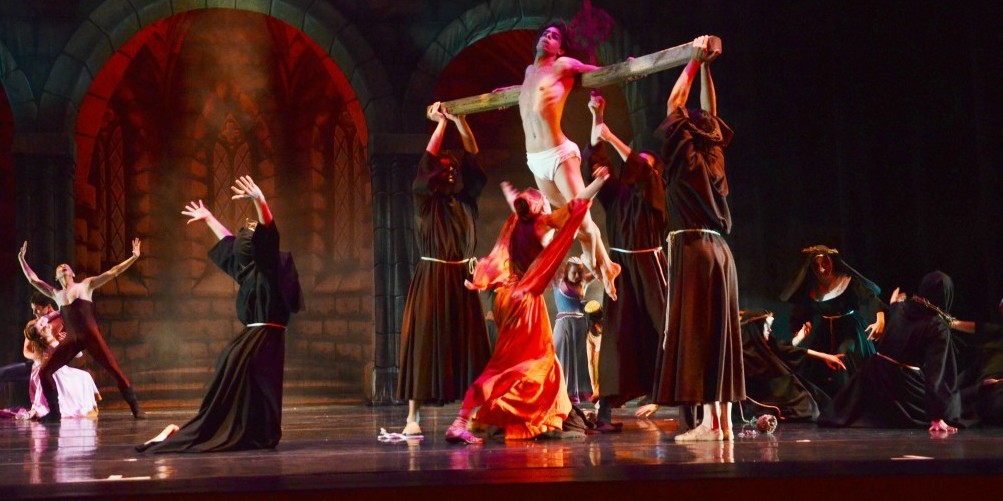
To put an exclamation point on its 50th season, Dance Alive National Ballet sought a performance that was dramatic and spectacular. Something glorious.
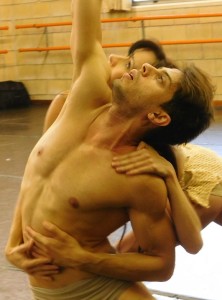
Carmina Burana, in so many ways, fits the bill.
“It’s lusty. It’s spiritual. It’s biblical. How can you miss?” said Kim Tuttle, executive artistic director of Dance Alive. “It’s a huge production!”
Some might even say epic. Carmina Burana involves 250 performers, including dozens of dancers, the UF Symphony Orchestra under the direction of Raymond Chobaz, the University Concert Choir and Gainesville Master Chorale under the direction of Will Kesling and three guest soloists in what is billed as “a celebration of the secular joys of life.”
This weekend, Dance Alive National Ballet will stage two performances of Carmina Burana at UF’s Curtis M. Phillips Center for the Performing Arts. There will be a Friday night show at 7:30 and a Saturday matinee at 2.
The weekend will be topped off Saturday night by Dance Alive’s Golden Gala at the Touchdown Terrace high above UF’s Ben Hill Griffin Stadium. The fundraising event will include a silent auction, an art sale and a special “Dancing with the Stars” competition featuring Dance Alive’s principal dancers paired with a dozen local celebrities and community leaders. The event will be streamed live so that people can vote for their favorite duo.
But before it can party, the Dance Alive company will give its all—twice—in Carmina Burana. (A third show is scheduled for Sunday at 2 p.m. at the Sharon L. Morse Performing Arts Center in the Villages.)
“It’s probably the most popular ballet, after Nutcracker, we’ve ever done,” Tuttle said.
The rousing music composed by Carl Orff sets the tone.
“The music from Carmina Burana is so dynamic and so recognizable that it’s one of those things that when you hear it, you say, ‘Oh yeah, I’ve heard that. Oh, I love this music!’” Tuttle said. “It’s so exciting.”
It is truly unique. It is the mostly widely performed choral work in the world.
— Raymond Chobaz, conductor
Orff, a German, wrote the music in 1930s after learning about the discovery of 24 thirteenth-century poems written by Goliards, monks who wrote satirical verses after abandoning their orders. It was their way of protesting the growing contradictions of the church.
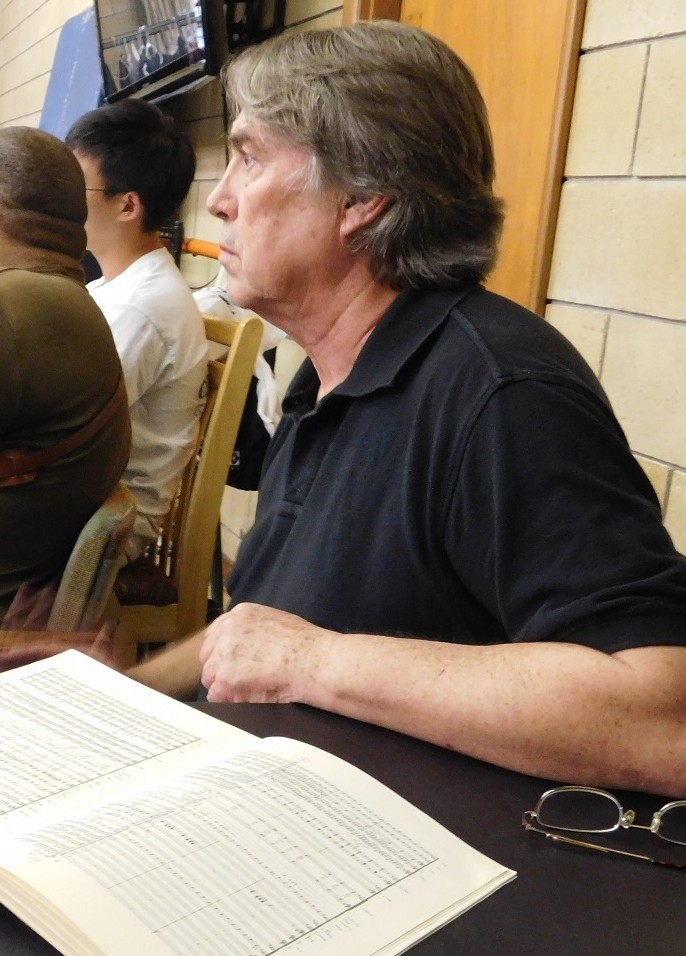
“It is truly unique,” Chobaz said about Orff’s composition. “It is the mostly widely performed choral work in the world. When it was written, they couldn’t believe it was intended as a dance.”
The monks’ songs, poetry and performances were considered “of the flesh,” celebrating the joys of living.
“They experimented and explored and saw what life had to offer outside the monastery,” Tuttle said. “You can imagine what that was like. So the opening scene is a procession of monks and nuns and the Mother Abbess and the Father Abbot. That’s what the Catholic choreographer [Tom Pazik] called them.
“Within their order, they got tempted. And that sets the mood. It’s like the quotation marks on the outside of a sentence.”
When he was called upon to choreograph Carmina Burana for Dance Alive in 1980, Pazik interpreted it as a story of mankind from the creation of Adam and Eve to the Apocalypse. Unlike most ballets, there is no conventional story line. Instead, the five main scenes weave “a spell of successive emotion with a fatalistic philosophy.”
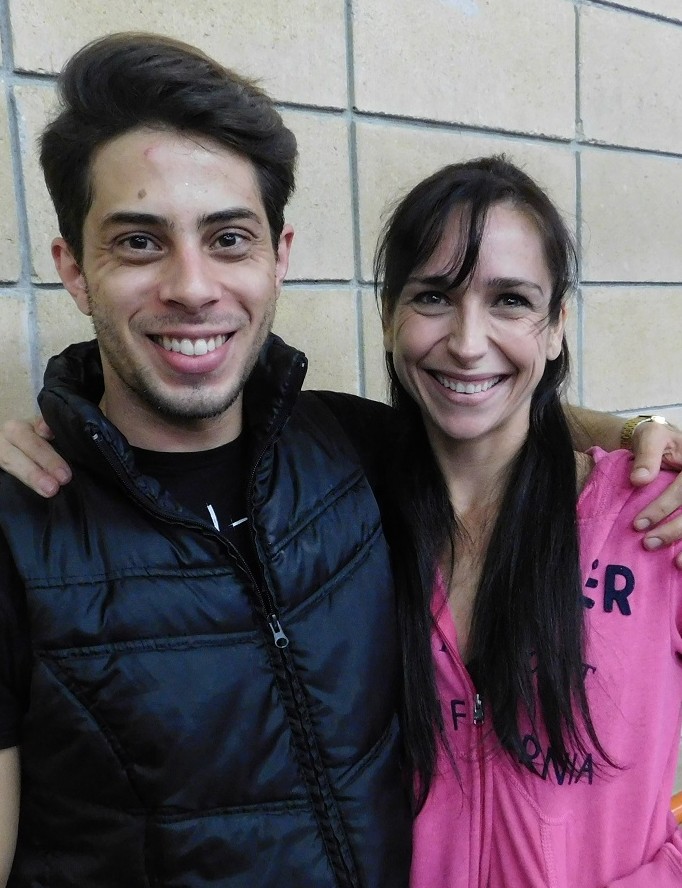
In Carmina Burana, the chorus is dressed in traditional monks’ robes and very much part of the onstage production, flanking the orchestra and making for a dynamic setting.
Once the prelude (O, Fortuna) ends, the stage is set for the arrival of Adam and Eve, as performed by Dance Alive principal dancers Fhilipe Teixeira and Carla Amancio. Temptation is performed by a serpentine Yulia Pivotskaya.
Amancio said the role is challenging because of the raw emotion Eve must convey to the audience without words.
“I should be very innocent and genuine because the snake is coming and she wants to give me the apple to give to Adam,” Amancio said. “At that point, I don’t know anything about life. Of course, the apple is bad and hurts him. When I see that I did something really bad, I feel shame.”
She added: “The scene is more about expressions and feelings than about dance technique.”
Amancio said the Adam and Eve scene is done tastefully and without a fig leaf in sight.
“We are both clothed!” Amancio said. “I never dance naked. I think when it’s not vulgar, you are doing your work with respect. You are not up there showing off your body. You are doing something that was right a long time ago and being artistic.”
Teixeira has performed in Carmina Burana previously, but this is an unfamiliar role.
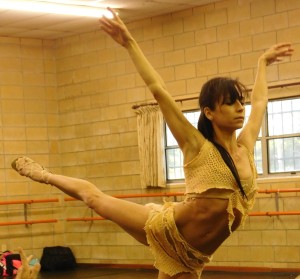
“I haven’t done Adam before, so it’s new for me,” he said. “It’s a matter of figuring out the right expression – how can I say everything to the audience through movement of the body and facial expression. I really enjoy that Kim is always asking me for more and more.”
Teixeira, 30, and Amancio, 36, are both from Brazil. In fact, they met each other at the Sesiminas Company of Dance there 12 years ago, just as Teixeira was joining and Amancio was leaving the company.
Teixeira is in his sixth season and Amancio in her eighth season with Dance Alive National Ballet. The ballerina is married to Andre Valladon, a Dance Alive principal dancer and its assistant artistic director. Valladon is also from Brazil and has also been with the company eight years.
Teixeira often joins Amancio and Valladon for dinner or they hang out together.
“We don’t have anybody else here in Gainesville. Fhilipe is my family here,” Amancio said.

In Carmina Burana, Teixeira and Amancio perform together as Adam and Eve early in the ballet but then perform a variety of roles in subsequent scenes. In the penultimate scene, they reunite as Apollo and Venus.
“In Carmina Burana, we have many different roles in one ballet,” Teixeira said. “That’s the most exciting and challenging thing about it.”
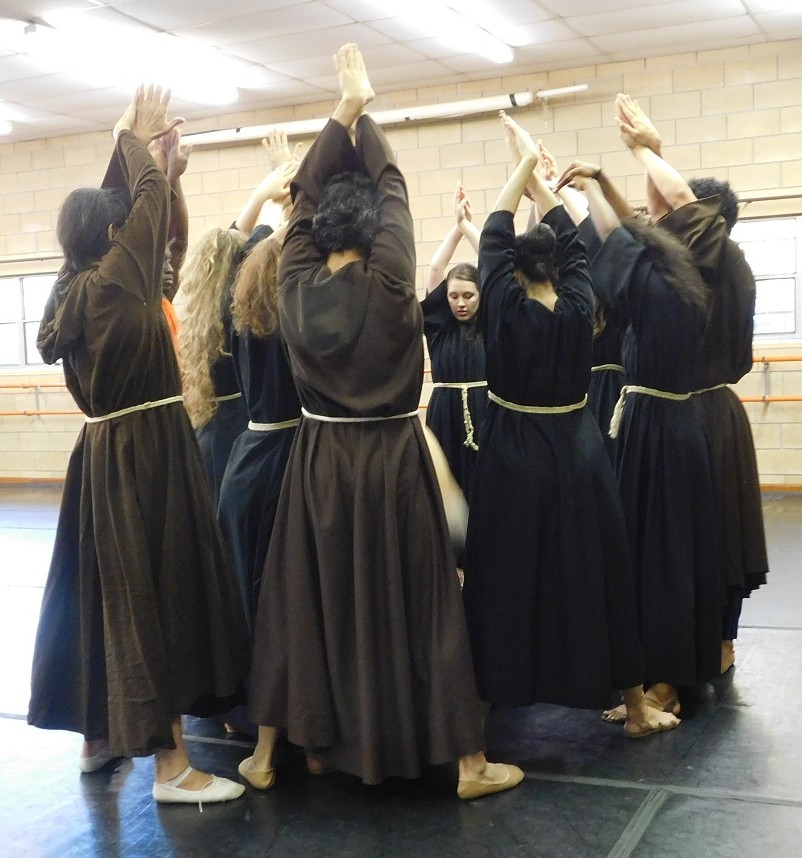
From Adam and Eve, the ballet progresses into Springtime, when nymphs and satyrs frolic across the stage in celebration of life. The scene includes a baritone solo by Anthony Offerle, associate professor at the UF School of Music.
The second act takes place in a tavern, where debauchery reigns.
“You see decadence, you see gambling, you see drinking, you see the baser level of humanity,” Tuttle said.
One of Teixeira’s most grueling yet visually stunning scenes is known as the Roasted Swan in the tavern. He is one of six dancers supporting the swan — another dancer — above the stage.
“It’s representational of the crucifixion of Christ, and I think it’s the deepest part of the ballet,” Tuttle said. “There are three poles and they’re held up by six dancers. It’s like a spit. The swan doesn’t touch the ground until the end, when he’s stabbed.”
Tuttle said the people holding up the swan are critical to the scene, and the size of the swan and the sensitivity of the swan to the people holding it up are equally important.
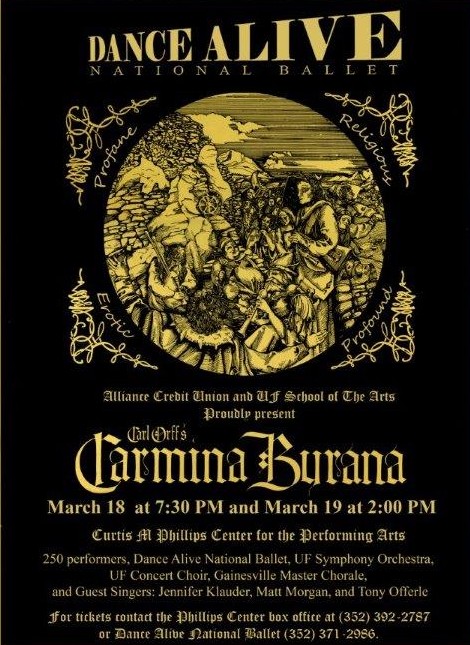 “Our dancers are all coordinated and they are all athletic, but not all of them are unafraid to hang from poles that people are lifting and moving around,” she said.
“Our dancers are all coordinated and they are all athletic, but not all of them are unafraid to hang from poles that people are lifting and moving around,” she said.
During the swan scene, tenor Matt Morgan performs a solo. Morgan is a visiting assistant professor in the UF College of the Arts and has performed onstage at New York’s Lincoln Center and around the world.
The third act of Carmina Burana is known as the Court of Love, which Tuttle describes as “chaste, pure and frustrating for both genders.”
Offerle and soprano Jennifer Klauder offer solo performances throughout the scene. Klauder, a Gainesville native, is the daughter of the late Agnes Klauder, who also was a soprano who performed with Dance Alive a number of times over the years. She passed away in December.
The performance concludes with an adoration of Venus and Apollo that, according to Tuttle, “descends into utter depravity.” An anti-Christ figure staggers onto the stage and seduces a Mary Magdalene figure.
“I’m sure when the audience sees the anti-Christ figure doing this, they’re like ‘Where is this going now?’” she said. “But within seconds, the real Christ comes walking in and blesses them.”
Are people offended by this depiction?
“No,” Tuttle said. “What we see is the real Christ. People who are Christians, this really touches them. We’ve had ministers and pastors who are not offended by it. They know what people are capable of doing and they know that’s why so many people need and want religion.”
— Noel Leroux
To purchase tickets for Carmina Burana or for further info, visit the Dance Alive website.

Your Comments